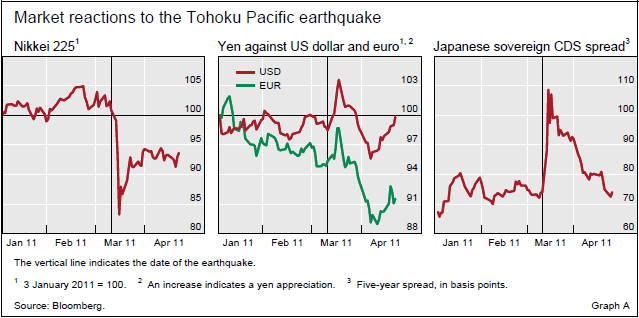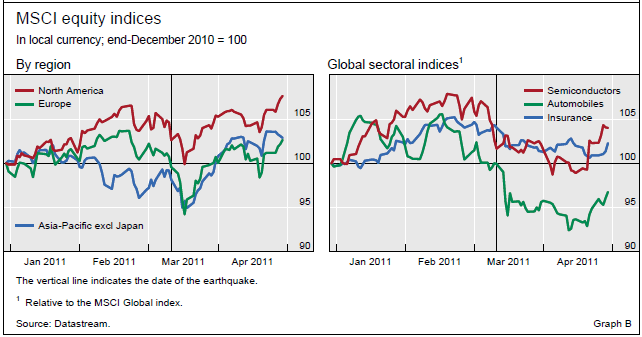The Japanese earthquake and tsunami
(Extract from pages 4-5 of BIS Quarterly Review, June 2011)
The destruction and human tragedy following the earthquake and tsunami in Japan have been huge. There was an immediate drop in economic activity due to damage to facilities, disruptions to supply lines and power shortages. Recent data releases show that household spending and production have plunged. Damage to the nuclear power plant in Fukushima and ensuing radiation leaks have added to the challenges. The possible implications of these events for the Japanese economy as well as the global economic outlook and financial markets are manifold, and uncertainties associated with these effects continue. Initial assessments by the Japanese Cabinet Office put the damage to the economy's capital stock at around $240 billion, which is more than double the damage following the Kobe earthquake in 1995. GDP declined by 0.9% on the previous quarter in the first three months of 2011. For the year, GDP growth is expected to be about 1 percentage point lower than earlier estimates.
Financial markets reacted very strongly in the immediate aftermath of the disaster (Graph A). The Tokyo stock market plummeted by almost 20% in the first two business days after the earthquake, and Japanese sovereign CDS spreads jumped by 30 basis points, probably reflecting concerns about the extra fiscal burden implied by reconstruction. The foreign exchange market was also very volatile, with the Japanese yen appreciating sharply against the US dollar, reaching a high of 76.3 on 17 March. Reportedly, this was driven by market speculation that Japanese insurance companies would repatriate US dollar funds to meet yen-denominated claims.
The Bank of Japan responded swiftly. To ensure ample liquidity, it offered funding of ¥82.4 trillion in the first week after the earthquake, of which ¥57.8 trillion was actually provided to the market. The Bank also increased the amount of its asset purchase programme by ¥5 trillion, to prevent a deterioration in risk sentiment from adversely affecting output. In response to the yen's sharp appreciation, the Ministry of Finance and the central bank, together with other G7 countries, embarked on a concerted intervention in the foreign exchange market.
On 6-7 April, the Bank of Japan unveiled a ¥1 trillion special lending facility to channel funds to banks for lending to distressed businesses in the affected areas, and broadened the range of eligible collateral assets for money market operations. In addition, the government announced a supplementary budget of ¥4 trillion for reconstruction purposes on 22 April. These measures supported market functioning despite the severity of the shock. Markets calmed quickly after their initial reaction: the stock market recovered somewhat; the yen retreated to trade in the range of 82-83 against the US dollar; and Japan's CDS spread declined.
Outside Japan, the impact on financial markets was limited, and largely confined to sectors seen as being most directly affected by supply chain disruptions or direct loss exposures. A primary concern in financial markets has been that an extended period of power shortages in Japan might adversely affect industrial production through global supply chains, given that Japan is a major producer of components for the semiconductor and automotive industries. Thus, while broad equity market indices have shown signs of resilience (Graph B, left-hand panel), certain sectoral indices fell sharply following the news of the disaster, and have subsequently recouped only part of their initial losses (Graph B, right-hand panel).


